5 Top Compound Leg Exercises for Strength and Functional Fitness
Looking to build strength, muscle mass, and functional mobility in your lower body? Look no further than compound leg exercises!
These powerful movements work across multiple muscle groups and joints simultaneously. This can help you increase your muscle activation during workouts and improve your physical coordination.
You’re probably familiar with a few key compound leg exercises. Take squats, deadlifts, and lunges, for example. In this article, we’ll break down why these moves are so beneficial and how to incorporate them into your workout routine.
Whether you are an athlete, a gym enthusiast, or just looking to improve your daily functional movements, like walking, standing, or jumping, compound leg exercises are a fundamental staple to master for your overall fitness.
To start, let’s learn what compound moves are and how they differ from other exercise types.
What are Compound Exercises?
Before we discuss the six best compound leg exercises for strengthening your hamstrings, glutes, and quads, you might be wondering: “What is a compound exercise anyway?”
If you’re just starting from scratch, we’re happy to report that this is a very straightforward term.
“Compound” describes any type of movement that enlists multiple muscle groups and joints at the same time.
The opposite type of exercise is called an isolation exercise, which works only across one main joint or muscle group. In a study on single vs. multi-joint resistance exercises (in other words, isolation vs. compound), both training styles were found to be effective for muscular strength and maximizing muscle hypertrophy (muscle growth).
That said, compound movements have additional advantages, like saving you time. We’ll explore them in more detail later in this article.
For an example of a compound exercise, you can think of something like a squat (ankles, knees, hips), or a bench press (elbows, shoulders). These are considered foundational movements that you use to build your overall strength and functional fitness. Other compound exercises include:
- Deadlifts
- Rows
- Pull-Ups (which is also a great compound back exercise)
- Push-Ups (One of the best compound chest exercises)
Typically, these exercises mimic the way your body naturally moves and involve big muscle groups, leading to greater muscle activation and building up your coordination. As such, you usually want to keep your compound lifts heavy.
Isolation lifts, on the other hand, can be used for what we call “accessory exercises,” meaning lifts that are lighter or used to supplement your core lifts on any given day.
Since they work multiple muscles at once, compound exercises are useful for developing overall body strength, making you a better athlete and maximizing the time you use to work out.
Take a look down below for some benefits that compound exercises (in this case, compound leg exercises) can offer you.
5 Best Compound Leg Exercises
Compound leg exercises are your big power moves that work to get your leg muscles maxing out on strength.
And if you’re a novice to the gym, you’re in luck! Most of these moves are simple exercises that are easily accessible or can be modified for beginners.
Take a look at the top compound leg moves you can do to build up your leg strength and muscle mass.
1. Squats
The “king of exercises,” look no further than the almighty squat if you’re hoping to work towards more powerful thighs.
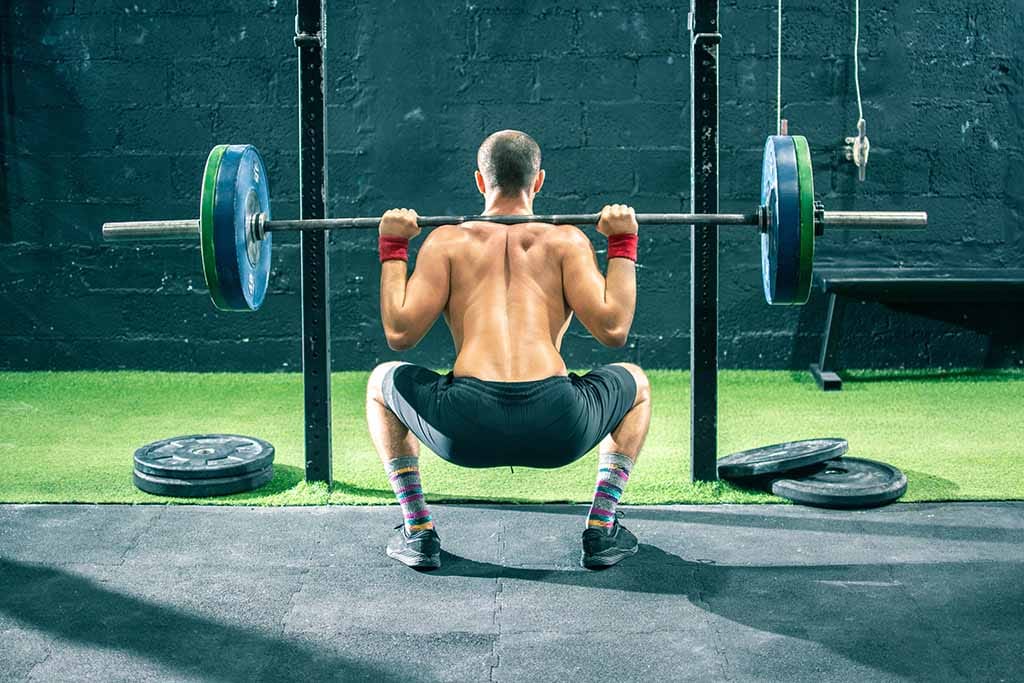
Let’s break it down.
- Set-Up: Stand with your feet shoulder-width apart. Point your toes slightly outward, at around 15 degrees. If you want to make this move more advanced, set up a barbell on your upper back/traps. Ideally, you should be lifting heavy weights in your squat, working toward progressive overload, but start with just the bar or your body weight if you’re new to working on squat technique.
- Body Position: Keep your chest up, core engaged, and back straight. Make sure your wrists are straight and engaged, not cocking back as you grip your barbell.
- Action: Lower your body by bending your hips and knees, keeping your weight on your heels. Aim to get your thighs parallel to the ground, with your knees coming to a 90-degree bend.
- Reverse: Drive through your heels to come back to standing, extending your hips and knees.
- Reps: 3-4 sets of 8-12 reps.
2. Deadlifts
Deadlifts are the other half of your legs’ deadliest sculpting duo. Along with the squat, they’re one of the maximum weight lifts you should be doing if you’re serious about building your leg muscles.
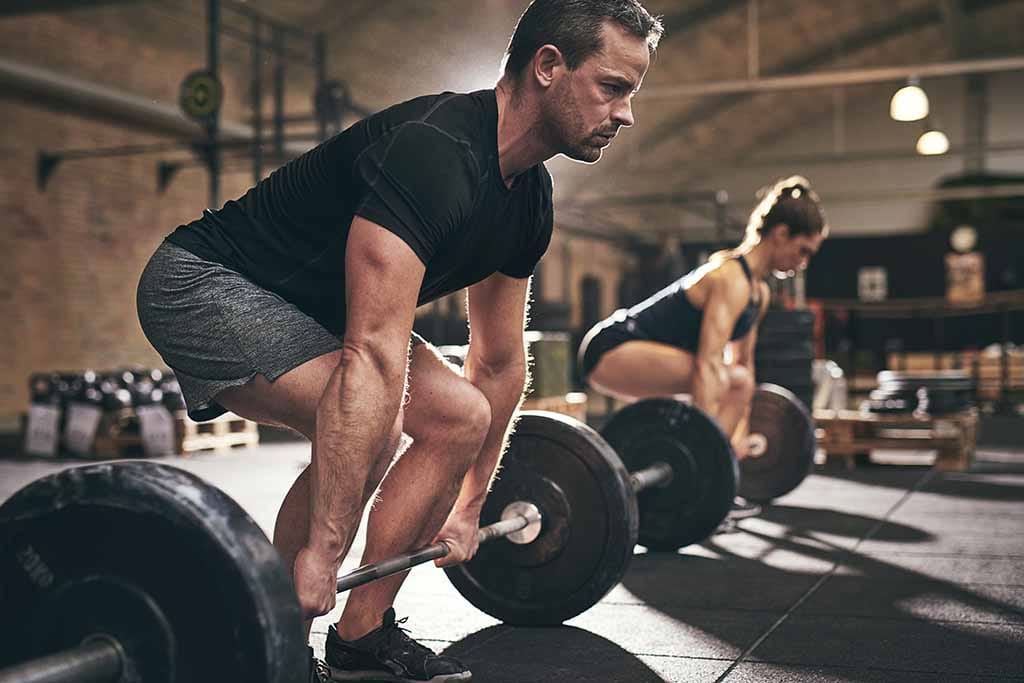
To deadlift:
- Set-Up: Stand with your feet hip-width apart. Keep your barbell on the floor over your mid-foot area.
- Body Position: Bend at the hips and knees, hinging forward to grab your bar with an overhand grip. Keep your back straight and chest upright.
- Action: Lift the barbell by extending your hips and knees. Keeping the bar close to your body, thinking of rolling it along your shins.
- Reverse: Lower the bar back to the floor by hinging back through your hips and bending your knees.
- Reps: 3-4 sets of 6-10 reps.
Pro-Tip: You can use deadlift variations to be either more glute-dominant or more hamstring-dominant. If you want to work on a Romanian deadlift (RDL), which targets the glutes to help you build a round butt, start with the barbell lifted so you are standing up straight and holding your barbell.
Learn more about the different deadlifts you can work on using these articles as your guide:
3. Dumbbell Lunges
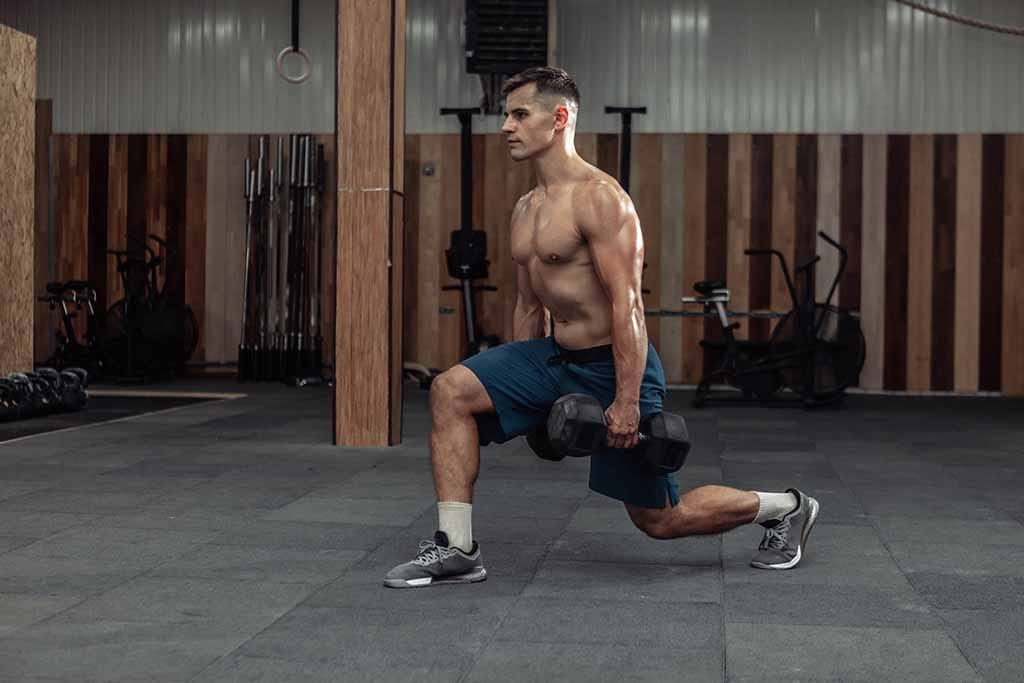
- Set-Up: Stand with your feet together, holding medium weight dumbbells at your sides. Alternatively, you can balance a barbell across your upper back (over the traps).
- Body Position: Keep your chest up and core engaged.
- Action: Step forward with one leg and lower your body until both knees come to a 90-degree angle.
- Reverse: Push through your front heel to straighten your legs, coming back up to standing.
- Reps: 3-4 sets of 10-12 reps per leg.
4. Bulgarian Split Squats
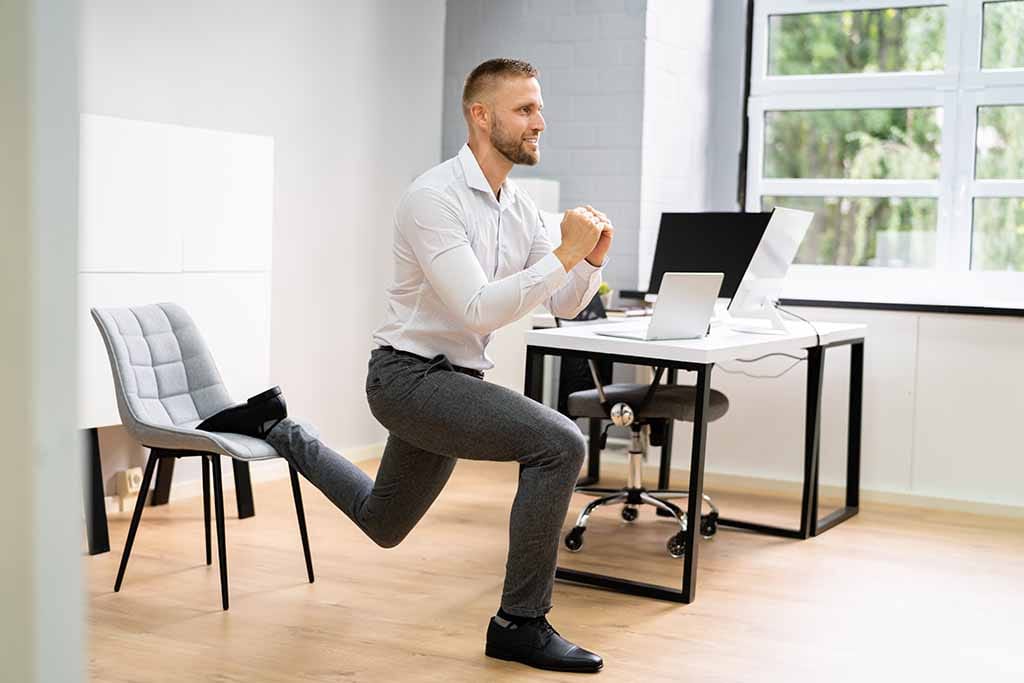
- Set-Up: Stand in front of a weight bench, turning away, with the back of one foot resting on the bench behind you. Hold a set of dumbbells at your sides or a barbell on your upper back.
- Body Position: Keep your chest proud and engage your abdominals.
- Action: Bend your front knee to lower yourself down so that the knee comes to a 90-degree bend. Make sure your back knee is tracking downward, in line with your torso.
- Reverse: Drive out of your front heel to come back up to standing.
- Reps: 3-4 sets of 10-12 reps per leg.
5. Leg Press
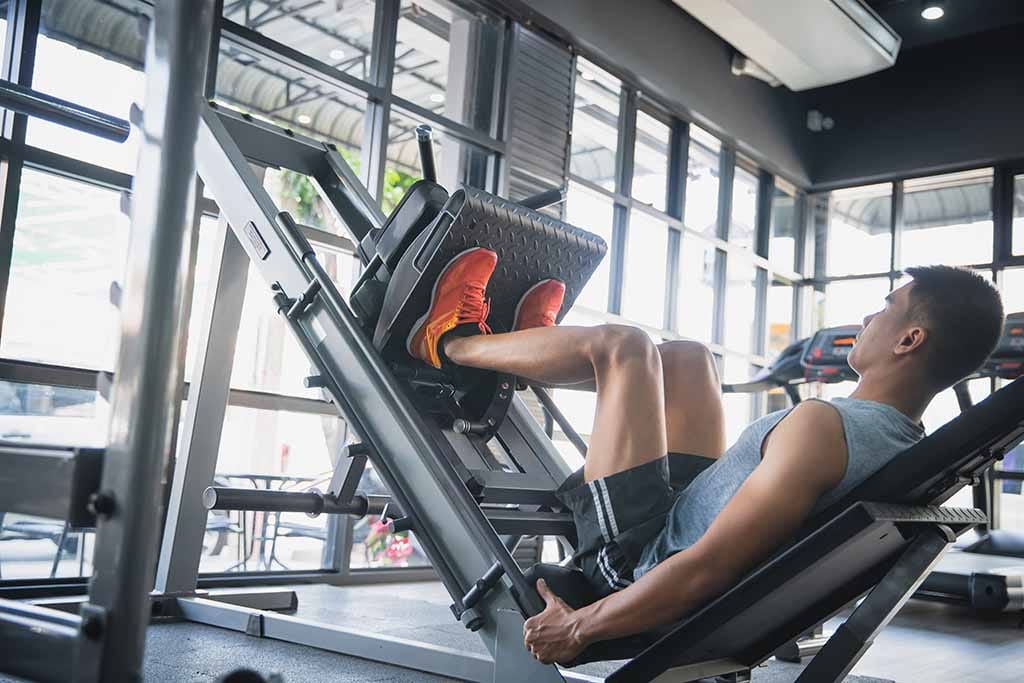
- Set-Up: Sit on a leg press machine with your feet shoulder-width apart on the footplate. You can also explore other leg press foot placements, including wide or narrow feet.
- Body Position: Keep your back and head pressed against the backrest. Brace your core while still breathing comfortably as you move.
- Action: Let the platform lower towards you by bending your knees toward your chest.
- Reverse: Push the platform away from you, extending your legs. Don’t lock your knees, and keep a slight bend. This will help you avoid injury.
- Reps: 3-4 sets of 10-15 reps.
Benefits of Compound Leg Exercises
Here are some of the benefits of doing compound leg exercises.
1. More Muscle and Strength
Compound leg exercises engage multiple muscle groups simultaneously for better muscle activation and growth. When you squat or deadlift, for example, you target major leg muscle groups like your quadriceps (quads), hamstrings, gluteal muscles (glutes), and calves.
This helps you strengthen your lower body holistically. Considering that the lower body acts as your “base,” not only in sports but even for simple activities like walking, ensuring these muscles are strong is crucial for everyday functions that you might overlook!
If you’re working on strength development, building leg strength is a key component of a physique with balanced overall strength.
2. Athleticism and Functional Movement
Back to the above point, these exercises mimic everyday movements and activities that you would make in your daily life.
Training on top of just using your legs normally helps to enhance your functional strength and muscular coordination. If you’re an athlete, this type of functional fitness can translate to better performance in sports and other physical activities or even just things you do every day.
When you’ve built up your lower leg muscles and joints, you’re also less injury-prone.
Better Stability and Balance
Compound leg exercises aren’t just for your legs.
Most of these moves require a lot of core engagement to keep you upright. Maintaining good form and balance within an exercise works a lot of smaller stabilizer muscles that originate from your core.
You can work on your abs in a double-duty way by incorporating compound leg exercises such as squats and lunges, which require balancing. Keep in mind, though, that you'll still need to specifically train your abs.
This can contribute to better posture and lower back pain. On that note, do you find your lower back is screaming as you try to work your legs? Read Lower Back Pain When Squatting to get familiar with some simple solutions you can use to alleviate this problem.
Bonus points: We’ve got a guide for Hip Pain When Squatting as well. Hopefully, these guides will help you squat low with maximum ease.
Reduce Excess Body Fat
Because compound exercises work for multiple large muscle groups, they bring your heart rate up and increase your calorie burn. Typically, they’re more demanding on your metabolism during and after workouts than isolation exercises (this is also in part because you’re usually lifting more weight with compound moves).
More calorie burn can help you cut extra body fat. This can help you slim down to lose unwanted points. If you’re working towards body recomposition, they can be a good way to build muscle on a lean bulk too.
Ultimately, though, the best thing for fat reduction is any kind of workout that prioritizes cardiovascular exercise. Mainly workouts like:
- Jogging
- Cycling
- Rowing
- Jump rope.
Though we don’t commonly think of these as compound leg exercises, all these workouts incorporate some kind of light squatting movement or hip and knee bend in their form.
Combine these moves in your workout plan with heavier squats and deadlifts and you should notice your body fat start to melt away.
Time Saver
Working several muscles at once can make your workouts fly by much quicker. This helps you maximize your workout efficiency.
Rather than isolating each muscle group individually, you can train your whole leg in less time. If you have a hectic schedule, this would be an ideal option.
Is Leg Press a Compound Exercise?
You bet!
The leg press works across multiple joints, including your hips, knees, and ankles. It also engages all your major leg muscles, including the quads, hamstrings, and calves.
Since it does many things at once, the leg press is classified as a compound exercise. Want to know how to press for success?
Check out a few simple instructional articles on how to improve your leg press:
Big Picture
Compound leg exercises come with a host of benefits like more muscle mass and strength, better functional fitness, and core stability and balance.
These exercises mimic everyday movements. If you’re in a sport, this can help you outperform the competition. But even in daily activities like walking, running, sitting and standing, training all the muscles of your legs to work cooperatively is a great way to reduce pain or stiffness and prevent injuries.
Overall, compound leg exercises are great for lower body training. When you do them at higher or faster rep ranges, they can even bring your heart rate up, helping you burn calories. This can help you lose fat for an aesthetic workout that may help you get your best physique yet.
Get a leg up on your training. The Flex App progresses as you do with plate tracking capabilities and auto progression. Try it out for free today.
References
Gentil, P., Soares, S., & Bottaro, M. (2015). Single vs. Multi-Joint Resistance Exercises: Effects on Muscle Strength and Hypertrophy. Asian journal of sports medicine, 6(2), e24057. https://doi.org/10.5812/asjsm.24057
Kak, H. B., Cho, S. H., Lee, Y. H., Cho, B. J., Kim, J. W., Oh, B. D., & Koh, H. W. (2013). A study of effect of the compound physical activity therapy on muscular strength in obese women. Journal of physical therapy science, 25(8), 1039–1041. https://doi.org/10.1589/jpts.25.1039
Krzysztofik, M., Wilk, M., Wojdała, G., & Gołaś, A. (2019). Maximizing Muscle Hypertrophy: A Systematic Review of Advanced Resistance Training Techniques and Methods. International journal of environmental research and public health, 16(24), 4897. https://doi.org/10.3390/ijerph16244897
Related articles


Get fit with Flex
Build muscle & lose weight fast for free.
Available on iPhone + Apple Watch





